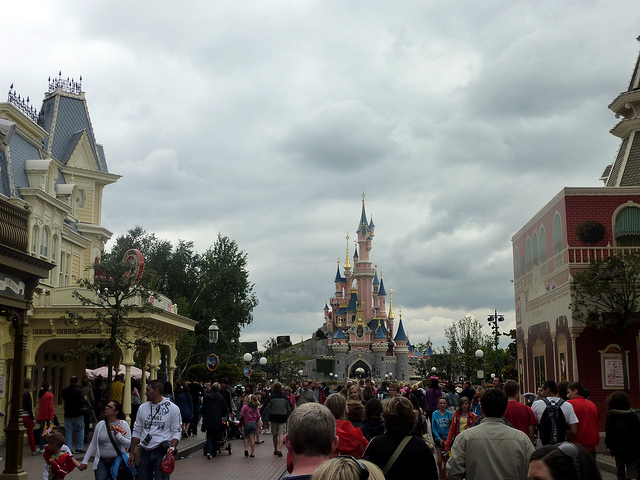The following essay from February 2019 was the sole post on Transforming the Game, a short-lived blog focused on business innovation and transformation. You’ll note that instead of making the source references live links, they are essentially footnoted. At the time I was considering a print dimension and experimenting with how that would look. Also, I wanted to possibly turn this into a syndicated column. Fascinating topic but I’m focusing on art!
Disneyland and the Transformation of Disney
Disneyland by Sean MacEntee – CC License
Disney is a fascinating company with a rich history of both incredibly successful changes over time as well as some monumental failures. In the early years (1), the Disney brothers worked out of a rented back office but they soon began construction on their own studio in Los Angeles. Fourteen years after they first rented that back office, they debuted “Snow White and the Seven Dwarfs” and, at this point, one might say the rest is history. But that was more the prelude to the building of an empire, one that later almost ran into a major roadblock with the clearly visionary effort to create Disneyland.
Establishing Disney
The success of their animated feature, a first of its kind, gave the Disney brothers an opportunity to build an even better and bigger studio in Burbank. This then enabled them to raise production standards and build a powerhouse of tv and movie creation. One could say the early experience of building the Disney Brothers Cartoon Studio provided Walt Disney with multiple inspirations that led to the invention of the theme park.
He had the daily experience of working in a dedicated environment that was different from the outside world and focused on the creation of fantasy. He also had the experience, as did ultimately millions, of seeing those fantasies in movie theaters, spaces dedicated to the experience of films such as those Disney was creating.
At this point Walt Disney could have decided to go vertical and begun to buy up movie theaters around the country or to build a chain of Disney Theaters that would first take over the U.S. and then move abroad. A Supreme Court decisions in the late 40s (2) initially made that impossible but the company did make an entry into the theater business in the 80s after Walt Disney’s death. However, that move ultimately led to a group of flagship theaters for premieres and special releases rather than a full-fledged chain of theaters.
In 1953, Disney launched Buena Vista Distribution (3) to distribute Disney releases which gave the company much more control over how their film and tv productions were released to their growing audience of fans. This move laid the foundation for a “long period of stability” (4) which freed Walt Disney’s mind to move forward with even grander possibilities he had already been considering.
Inspiration and Early Concepts
Numerous points of inspiration and stages of development led to the creation of Disneyland. Walt Disney is said to have been most inspired by taking his daughters to amusement parks in the 30s and 40s (5) and realizing that amusement parks of the day were not great environments for family outings. He is also said to have considered plans for a park on eight acres next to the Disney studios (6) prior to World War II.
In 1948, after a visit to Henry Ford’s Museum and Greenfield Village in Michigan (7), Walt Disney wrote an extensive description of a theme park based on American culture. It was designed to be a great place for families to visit and enjoy together. It also sounds quite a bit like an old timey movie set transformed into a small town of its own. Walt Disney continued to iterate the concept that ultimately led to Disneyland, a place where Disney characters would come to life. Disneyland was also intended to be a place that was very family-friendly and would include educational elements in addition to entertainment.
From Rocky Beginnings to Outsized Success
Walt Disney’s vision was not shared by everyone at Disney. It led to the resignation of multiple board members (8) and a split with his brother (9). But after numerous negotiations, stops and starts and business deals, Walt Disney eventually secured funding for the park (10) and, in 1955, Disneyland opened for business. By all accounts it was a disaster (11). Tickets were forged, logistics were shaky and many things did not work as planned. Yet, Walt Disney moved forward, learning from failure, to create the world’s first theme park and to ultimately take the Disney legend to entirely new heights.
What at first was considered a poor business idea became a major revenue center with multiple parks around the world. Disneyland is also arguably where the foundation was created for the Disney Store which features an immersive experience for buying Disney memorabilia. Though the stores were not introduced until 1987 (12), they are, in many respects, smaller versions of Disneyland itself.
Much has happened in the world of Disney since the launch of Disneyland in 1955. But Walt Disney’s visionary approach to creating entirely new worlds led to far more than movie and tv productions. Disney became not only a creative business empire but a deep part of both American and world culture.
Sources:
1) https://studioservices.go.com/disneystudios/history.html
2) http://www.cobbles.com/simpp_archive/studio-theaters_today.htm
3) https://en.wikipedia.org/wiki/Buena_Vista_(brand)
4) http://www.plosin.com/beatbegins/projects/fischer.html
5) https://en.wikipedia.org/wiki/Disneyland
6) http://www.justdisney.com/disneyland/history.html
7) https://www.waltsapartment.com/walts-first-vision-of-disneyland/
8) https://en.wikipedia.org/wiki/Disneyland,_Inc.
9) http://www.plosin.com/beatbegins/projects/fischer.html
10) https://en.wikipedia.org/wiki/Disneyland,_Inc.
11) http://www.plosin.com/beatbegins/projects/fischer.html
12) https://dpep.disney.com/wp-content/uploads/sites/7/2016/08/pk_disney_store_fact_sheet_050616.pdf
Related Post:
Transforming The Game: The Backstory
